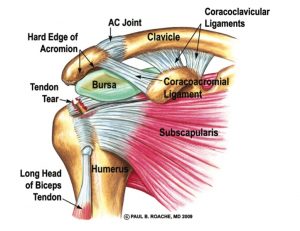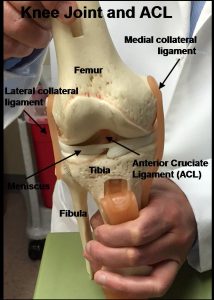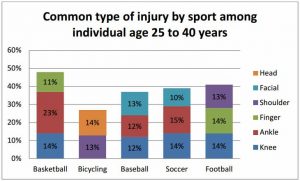Posted May 2, 2016
By WYATT GELLER
Last summer, I was on the tennis court for a weekend match and my opponent suddenly collapsed to the ground grasping his right calf. This opponent was no stranger, it was my dad.
Fortunately, my dad did not need surgery and he recovered with rest and some physical therapy. This event got me thinking about common sports injuries that occur to weekend warriors. The weekend warrior is any non-professional athlete, like you or me, that does sports occasionally on weekends and is susceptible to sports injuries.
Dr. Gautam Yagnik is an orthopedic surgeon at UHZ Sports Medicine Institute in Miami. He is the chief of Orthopedic Surgery at West Kendall Baptist Hospital. He is the team physician and Orthopedic Surgeon for the Miami Dolphins football team and the Florida Panthers hockey team.
Yagnik said there are two basic types of sports injuries that occur in the weekend warrior. The first type is more common and is the “over-use” type of injury. Examples of over-use injury include tendonitis, twisted ankle or sprained ankle, pulled muscle and stress fracture. These usually result from over-training or improper training.
According to Yagnik, the second type of injury seen is a traumatic injury. This can result when someone gets hit during a contact sport, leading to tissue damage. These injuries include torn ligaments or cartilage or broken bones.
The best way to prevent over-use injuries is “good preparation,” according to Yagnik. This means warming up with stretching and cooling down at the end. Also, conditioning and strength training are important.
“Traumatic injuries are more difficult to prevent due to the uncontrolled setting,” said Yagnik.
Wearing the appropriate padding and equipment as well as proper training can help to minimize these injuries.
Edward Garabedian is a physical therapist and assistant vice president for The Center for Orthopedics and Sports Medicine at Doctors Hospital in Coral Gables. He has been a physical therapist for 30 years and has a vast experience treating common sports injuries.
He explained the difference between a “sprain” and a “strain” which are both common sports injuries in the weekend warrior. A sprain is the stretching or tearing of a ligament. Ligaments are connective tissue that connect bone to bone, or cartilage to cartilage, in a joint.
Sprains occur when a joint is forced beyond its normal range of motion, such as turning or twisting of the ankle. Symptoms include pain, inflammation and limited ability to move an extremity.
This contrasts with a strain which is the stretching or tearing of a muscle or tendon. Tendons are connective tissue that connect muscle to bone. Strains occur when a muscle is stretched and suddenly contracts. This can occur with running or jumping and a frequent injury is a hamstring strain. Symptoms for an acute muscle strain include pain, spasm, loss of strength, and limited range of motion.
“It can take six to eight weeks to recover from a sprain or strain. Muscle injuries tend to recover quicker than ligaments because they are more vascular,” according to Garabedian.
In addition to the sprains and strains, other sports injuries of weekend warriors include shin splints, tennis elbow, anterior cruciate ligament (ACL) tear and rotator cuff tear.
According to the American Academy of Orthopedic Surgeons (AAOS), shin splints (also known as medial tibial stress syndrome) “are a common exercise-related problem.” The term “shin splints” refers to pain along the inner edge of the tibia (shinbone), and are often brought on by running. Stretching, rest and ice are used to treat and prevent shin splints.
Tennis elbow (also known as lateral epicondylitis) “is a painful condition of the elbow caused by overuse” during tennis or other racquet sports, and treatment options including, rest, NSAIDs, physical therapy, wearing a brace, steroid injections or shock wave therapy, according to the AAOS.
A serious knee injury is an anterior cruciate ligament (ACL) tear. The ACL runs diagonally in the middle of the knee and provides stability.
“Athletes who participate in high demand sports like soccer, football and basketball are more likely to injure their anterior cruciate ligaments,” according to AAOS, and surgery is usually required to rebuild the ligament.
In the shoulder, a rotator cuff tear is a frequent cause of pain and disability. According to AAOS, “nearly two million Americans a year develop a rotator cuff problem, and most tears occur in the supraspinatus muscle and tendon, but other parts of the rotator cuff may also be involved.”
Daily activities such as brushing your hair or putting on a shirt are painful. Treatment options include rest, physical therapy, non-steroidal anti-inflammatory drugs (NSAIDs), and steroid injections, but surgery may be required if the pain does not improve.
Sports injury statistics are tracked by the U.S. Department of Health and Human Services (HHS). Within HHS, the Office of the Assistant Secretary for Planning and Evaluation (ASPE) prepares a report on common sports injuries.

An image of a rotator cuff tear, showing a tear in the supraspinatus tendon (Image courtesy of Paul Roache, M.D., used with permission).
According to the U.S. Consumer Product Safety Commission’s National Electronic Injury Surveillance System (NEISS), nearly two million individuals had a sports-related injury that was treated in an emergency department in 2012.
Of course, this is a gross underestimation of the actual number of sports injuries, because many are treated at home and never presented to an emergency room. Basketball and bicycling are the sports that result in the most injuries resulting in an emergency department visit.
| Sport | ED visits 2012 | Hospitalizations 2012 | Percent Male |
| Basketball | 570,000 | 8,000 | 93 |
| Bicycling | 557,000 | 42,000 | 71 |
| Football | 446,000 | 10,000 | 88 |
| Baseball/Softball | 265,000 | 4,500 | 73 |
| Soccer | 231,000 | 5,000 | 83 |
Note: E.D. is emergency department visits.
Source: ASPE computations from U.S. Consumer Product Safety Commission’s National Electronic Injury Surveillance System for 2012.
Among children ages 6 to 19, sports-related injuries make up about 20 percent of all injury-related emergency department visits. Nearly 12 million individuals between the ages of 5 and 22 years suffer a sports-related injury annually, leading to 20 million lost school days and about $33 billion in health care costs.
“At the youth ages, sports injuries are more common in females due to the differences in their muscular development,” Garabedian stated.
In youth basketball, almost 12 percent of girls seen in the emergency department for sports injuries were diagnosed with concussions compared to 7 percent of boys. Likewise in youth soccer, concussions are more common in girls (17 percent) compared to boys (12 percent), according to Arpit Misra, writing in an ASPE Issue Brief in Washington D.C.
In adults ages 25 to 40 in 2012, the most common injuries in basketball and soccer were fractured or sprained ankles and knees, followed by facial injuries and broken or dislocated fingers.
In bicycling, the most common injuries were head injuries and shoulder fractures or dislocations. In football, the most common injuries were broken or dislocated fingers, as well as shoulder and knee injuries. In baseball and softball, ankles and knees were the most frequent injuries, followed by facial injuries, according to the National Electronic Injury Surveillance System for 2012.
Injury location by sport among individuals age 25-40 is:
Source: ASPE computations from U.S. Consumer Product Safety Commission’s National Electronic Injury Surveillance System for 2012.



